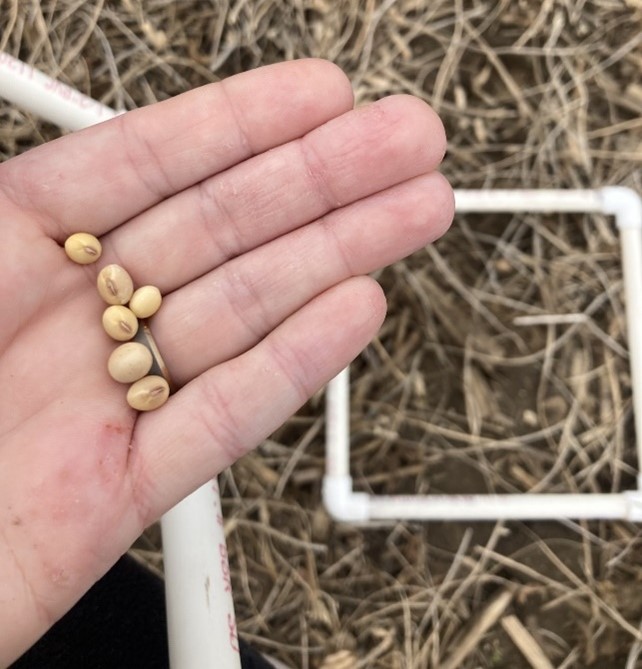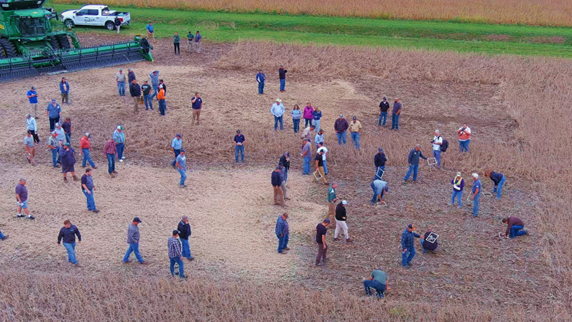Identify soybean losses during harvest and make adjustments
If you’re losing four soybeans per square foot, you are losing about 1 bushel per acre.

Few things could be more frustrating than to have spent time, money and effort growing a good crop of soybeans only to lose a significant part of the yield during harvest. Losses can occur at several points throughout the harvest process—lodging or pod shatter before harvest, header loss or insufficient threshing and separating. This article focuses on measuring and evaluating gathering loss from the header. For more information on reducing and responding to different types of soybean harvest losses, refer to Michigan State University Extension bulletin E3487 Reducing Soybean Harvest Losses.
Check for harvest loss just behind the header
Around 80% of harvest loss is from gathering. To measure this, harvest at speed long enough to receive a moisture reading. Then stop the combine and back up 15-30 feet to assess the area that has been harvested but has no residue spread on it.
Toss a 1-foot square frame
Use a 1-foot square frame (the one shown in the following picture is made from PVC pipe) to help quantify loss. Randomly drop the frame in 10 different locations across the width of the head. Choose areas that are representative of the majority of the swath. For example, avoid ruts or areas that had thin stands. Record the number of individual soybeans found within the frame for each location. If soybeans are still in a pod, count each soybean in the pod, not the pod as a whole. Note areas where intact pods are left behind. In this picture, six soybeans were found at one frame location.

Quantify and categorize loss
Find the average header loss by adding the soybeans counted in each frame location and then dividing by the number of locations. Then, divide the average header loss by 4. This final number is an estimate of how many bushels per acre are lost due to header performance. For example, if 10 frame locations are sampled and return a total soybean loss of 46, divide that by 10 for an average header loss of 4.6 soybeans. Take 4.6 and divide it by 4 for an average loss of just over 1 bushel per acre from your header.
Categorize losses by noting loose seeds in both standing beans and in the harvested area (some beans are on the ground before you get there with the combine), loose stems that didn’t run through the header properly, pods remaining on lodged stems and pods remaining on stubble.
Assess the findings
The goal is to reduce harvest losses to 3% or less. For example, if a historic yield average on the field is 50 bushels per acre, 3% of 50 is 1.5, so losses of 1.5 bushels per acre or fewer would be the goal. The above header loss example (header loss of 1.15 bushels per acre) is below the 1.5 bushel per acre threshold, so additional adjustments may not be needed or economical.
While most grain loss occurs at the header, other losses can come from threshing in the combine. Consult your equipment manual for items such as rotor or cylinder speed, fan speed, concave settings, ground speed, sieve and chaffer settings. Losses from these sources can be measured by conducting additional loss measurements from behind the combine as described above and subtracting the estimate of loss from the header. Sounds like a great way for youngsters to earn an allowance.
Gathering loss information gives producers an idea of where and how the losses are occurring. The patterns of loss as well as the number of soybeans recorded in each of the categories are all clues to what needs to be fixed, replaced or adjusted. This could be as easy as adjusting the reel speed or waiting until soybeans can be harvested at a higher moisture level, but it could also indicate that cutter knives need to be sharpened or replaced. Regular measurement, assessment and adjustments will help producers reach a goal of 3% or less harvest loss.

This article was produced by a partnership between Michigan State University Extension and the Michigan Soybean Committee.



 Print
Print Email
Email




